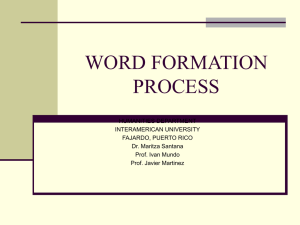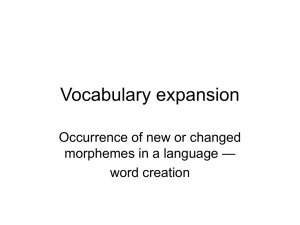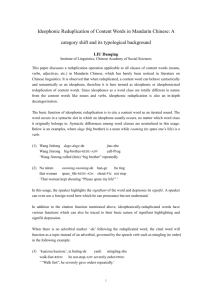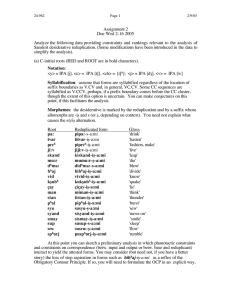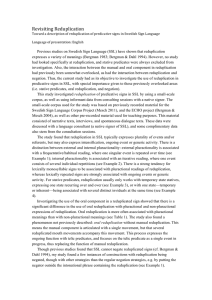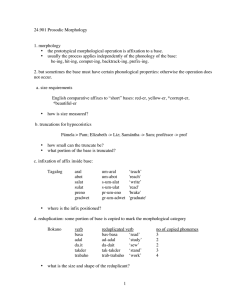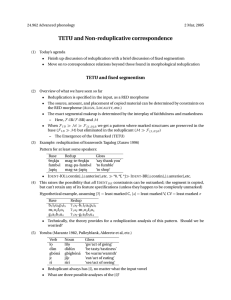Reduplication: Form, function and distribution Carl Rubino
advertisement
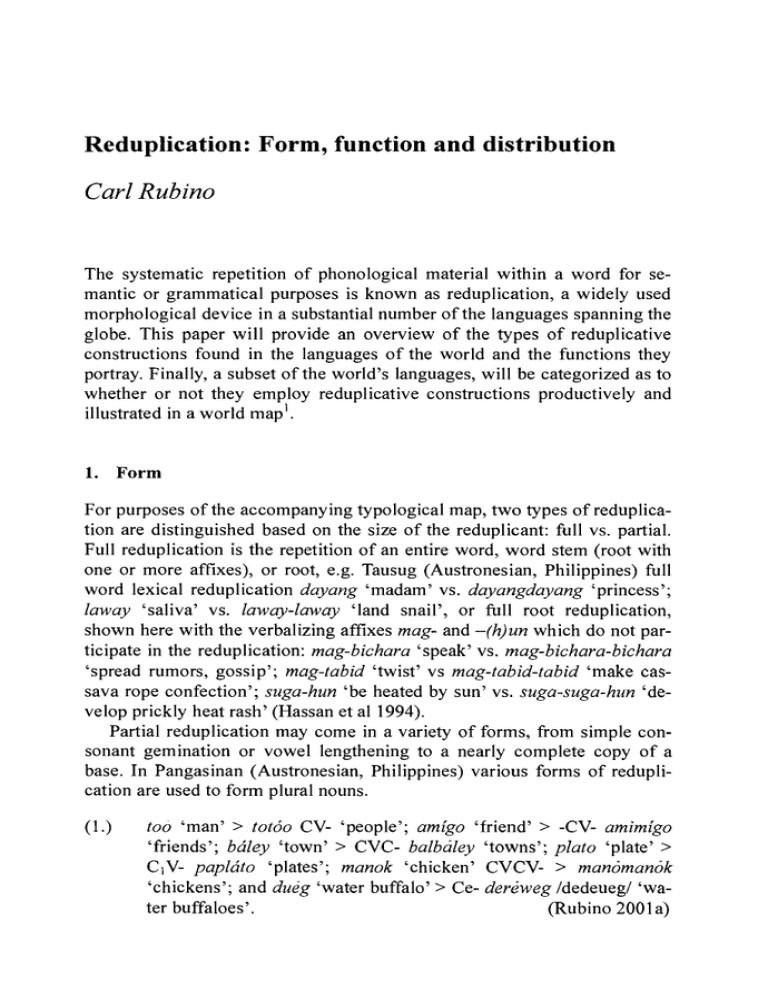
Reduplication: Form, function and distribution Carl Rubino The systematic repetition of phonological material within a word for semantic or grammatical purposes is known as reduplication, a widely used morphological device in a substantial number of the languages spanning the globe. This paper will provide an overview of the types of reduplicative constructions found in the languages of the world and the functions they portray. Finally, a subset of the world's languages, will be categorized as to whether or not they employ reduplicative constructions productively and illustrated in a world map'. 1. Form For purposes of the accompanying typological map, two types of reduplication are distinguished based on the size of the reduplicant: full vs. partial. Full reduplication is the repetition of an entire word, word stem (root with one or more affixes), or root, e.g. Tausug (Austronesian, Philippines) full word lexical reduplication dayang 'madam' vs. dayangdayang 'princess'; laway 'saliva' vs. laway-laway 'land snail', or full root reduplication, shown here with the verbalizing affixes mag- and -(h)un which do not participate in the reduplication: mag-bichara 'speak' vs. mag-bichara-bichara 'spread rumors, gossip'; mag-tabid 'twist' vs mag-tabid-tabid 'make cassava rope confection'; suga-hun 'be heated by sun' vs. suga-suga-hiin 'develop prickly heat rash' (Hassan et al 1994). Partial reduplication may come in a variety of forms, from simple consonant gemination or vowel lengthening to a nearly complete copy of a base. In Pangasinan (Austronesian, Philippines) various forms of reduplication are used to form plural nouns. (1.) too 'man' > totöo CV- 'people'; amigo 'friend' > -CV- amimigo 'friends'; bdley 'town' > CVC- balbaley 'towns'; plato 'plate' > CjV- papldto 'plates'; manok 'chicken' CVCV- > manomanok 'chickens'; and dueg 'water buffalo' > Ce- dereweg /dedeueg/ 'water buffaloes'. (Rubino 2001a) 12 Carl Rubino Ilocano (Austronesian, Philippines) employs a number of types of partial reduplication with various word classes, where the reduplicated material can be a partial root, simple root, a partial stem (bimorphemic entity), or a full word: (2.) Ilocano Reduplication Reduplicant Shape -C- Use Examples Animate/kin plurals CV- Plural argument; Animate plurals General plurals; Imperfective aspect; Comparison laldki 'male' > lalläki 'males' babai 'female' > babbdi 'females' ubing 'child' > ubbing 'children' na-lukmeg 'fat' > na-lulukmeg 'fat, distributive' ka-ili-άη 'townmate' > kakailiän 'townmates' kalding 'goat' > kalkalding 'goats' ag-bäsa 'read' > ag-basbäsa 'reading' dakkel 'big' > dakdakkel 'bigger' na-sam?it 'sweet' > na-samsam?it 'sweeter' Lexical iterativity Mutuality Lexicalized items ag-tilmon 'swallow' > ag-tilmotilmon 'swallow repeatedly' riipa 'face' > rupanriipa 'face to face' bänga 'pot' > bansabdnsa 'skull' tukdk 'frog' > tukaktükak 'wart' CVC- CVC(C)VCVC(C)VNFull Partial Reduplication Across Morpheme Boundaries Reduplicant Shape CV- CVC- Affixes Involved Pa- causative; -inn- reciprocal ma- potentive pa-causative Examples Ag-gi-p<inn>a-basol=zda VERB-PL-CAUS<RECiP>-blame=3p 'they are blaming each other' ma-turog 'sleep' > matmaturog 'sleeping' i-pa-damag'inform' > ipadpadamag 'inform, imperfecti ve' It has been hypothesized that languages with partial reduplication also make use of full reduplication (Moravsik 1978: 328), making semantic and grammatical distinctions in the use of the two reduplicative types as seen in Nukuoro (Austronesian, Caroline Islands, Carroll 1965). Reduplication: Form, function and distribution 13 14 (3.) Carl Rubino Nukuoro Total Reduplication gohu dark vai water hano go gada smile ivi bone ahi fire gohugohu vaivai hanohano gadagada iviivi ahiahi getting dark watery diarrhea laugh skinny evening Nukuoro Partial Reduplication seni sleep, sg. actor huge open, pi. goal ludu pick (trees) leisurely gai eat sseni hhuge lludu gagai sleep, pi. actor open, sg. goal pick trees frantically fish are biting Languages that employ partial reduplication may do so in various ways. Reduplicated material is most often found at the beginning of a base, but occurs also in medial and final position. (4.) Reduplicative Prefixes, Suffixes and Infixes Hunzib initial (N. Caucasian, Russia) CV(C) reduplication bat'iyab 'different' bat'bat'iyab 'very different' mugä-λ 'after' mu.muga-λ 'much later' (van den Berg 1995: 34) Choctaw (Muskogean, USA) medial CV reduplication tonoli 'to roll' tononoli 'to roll back and forth' binili 'to sit' bininili 'to rise up and sit down' (Kimball 1988: 440) Paumari (Arawakan, Brazil) final disyllabic reduplication a-odora-dora-bakhia-loamani-hi lpl-gather.up-REDUP-frequently-really-THEME 'we keep gathering them' (Chapman and Derbyshire 1991) The phonological nature of the reduplicated material varies from language to language and construction to construction. Reduplicative morphemes are often characterized by the number of phonemes included in the copy, C, CV, CVC, V, CVCV, etc., the number of syllables to be reduplicated, or the number of repeated morae. In Ngiyambaa (Australian), the reduplicant consists of a copy of the first syllable and a copy of a light version of the Reduplication: Form, function and distribution 15 second syllable, not including final vowel lengthening or a coda consonant (Donaldson 1980): magu-magu: 'around one', dhala-dhalarbi-ya (REDshine-PRS) 'to be pretty shiny'. The number of times a sequence is reduplicated is also a morphological factor in some languages, e.g. Mokilese (Austronesian, Micronesia) duplication vs. triplication: roar 'give a shudder' > roarroar 'be shuddering' > roarroarroar 'continue to shudder' (Harrison 1973). In Tigre (Semitic, Eritrea) internal reduplication of up to three internal syllables can be used. Each reduplication attenuates the meaning of the verb (Rose 2003: 114): (5.) dagm-a: d9ga:gsm-a: ddga:ga:g9m-a: d3ga:ga:ga:gsm-a: tell, relate tell stories occasionally tell stories very occasionally tell stories infrequently In some cases, the morpheme type of the reduplicant will depend on other factors. In Mangap-Mbula (Austronesian, Umboi Island, New Guinea), the reduplicant of intensive constructions occurs as a prefix with bases that have a long penultimate vowel, otherwise it is suffixed (Spaelti 1997), e.g. baä.da > bad.baä.da 'you (sg.) be carrying', boozo > bozboozo 'very many,' vs. molo > mololo 'very long', posop > posopsop 'you (sg.) be finishing.' In Kinyarwanda (Bantu, Rwanda), intensive verbal reduplication is only present with bisyllabic stems. Monosyllabic verbs (and verbal stems consisting of a monosyllabic root and a stem extension) and polysyllabic verb stems do not reduplicate (Kimenyi 2002: 265). Reduplicative constructions can also be characterized as being simple, complex, or automatic. A simple construction is one in which the reduplicant matches the base from which it is copied without phoneme changes or additions. A complex construction involves reduplication with some different phonological material, such as a vowel or consonant change or addition, or phoneme order reversal. Mangarayi (Australian) has a pluralizing reduplicative construction in which the first consonant of the reduplicant is a copy of the onset consonant of the second syllable of the base followed by the rime of the first syllable, sometimes accompanied by the suffix -ji or -//.The newly created syllable does not correspond to any constituent in the original word: gurjag 'lily' > gurjurjagj-i 'having lots of Ii 1— lies'; gaifi 'child of maternal grandmother's brother' > gaijaqj-iji 'children of maternal grandmother's brother'; j-imgan 'knowledgeable person' > j-imgimgan 'knowledgeable people'; barfgal 'egg' > baqgaqgalji 'having lots 16 Carl Rubino of eggs' (Merlan 1982). Some languages copy a short string of a root with extra material of varying lengths. In Yakan (Austronesian, Philippines), a morpheme consisting of the first consonant of the base, followed by the segment ew is used with some roots to express repetition or distributed action (Behrens 2002: 71): (6.) labo' duddag saget fall fall off mix lewlabo' dewduddag sewsaget keep on falling repeatedly fall off all mixed (several items) Imitative reduplication in Indonesian involves the creation of a root-like form which generally does not exist independently and differs from the root by a vowel or consonant change (Macdonald and Soenjono 1967: 54). belat ganti umbang tjoreng tjerai erot screen substitute float scratch sever crooked belat-belit gonta-ganti umbang-ambing tjoreng-moreng tjerai-berai erang-erot underhanded reciprocal drift to and fro full of scratches disperse zigzag In Limos Kalinga (Austronesian, Philippines, a certain iterative construction is used consisting of the prefix maka-, a copy of the first syllable of the base, a light copy of the second (minus the final consonant, if any), and gemination of the first consonant at the affix boundary (Ferreirinho 1993:90). (8.) maka-d-dawa-dawak maka-ng-ngina-ngina maka-s-saksa-saksak maka-l-ligwa-ligwat keep keep keep keep on on on on performing the curing ceremony buying washing getting/standing In Tuvan (Altaic, Siberia), diminutive 's' reduplication copies the entire base, except the initial consonant which is replaced by [s] in the reduplicant, e.g. pelek 'gift' > pelek-selek 'gift:DIMINUTIVE'. For bases that are vowel-initial, an onset [s] is added to the reduplicant, e.g. aar 'heavy' > aar-saar 'heavy :DIMINUTIVE' ; uuruk-suuruk 'simultaneously' (Harrison 2000). Tamil (Dravidian, India) displays a similar phenomenon where the initial CV of the reduplicated material is replaced by hi-, e.g. puli 'tiger' > puli kili 'tigers and other beasts'; maram 'tree' maram kiram 'trees and Reduplication: Form, function and distribution 17 other growing things'; kaappi 'coffee' > kaappi kiippi 'coffee and other beverages' (Schiffman 1999: 172). Patterns such as these exist in a number of languages and are collectively referred to echo constructions. Malak Malak, an Australian language from Western Arnhem Land, employs a construction with certain one or two-syllable verb roots to denote a pluralizing effect. As in echo constructions, a separate consonant is employed with the reduplicated material, however, a smaller part of the base is actually copied. This reduplication involves the use of a liquid consonant [r], [r] or [1] between reduplicated vowels (Birk 1976: 95-96): (9.) Singular Verb lam furk kulpat tikal karkwat Plural Verb laram fururk kulparat tikalal kararkwarat Gloss talk bury; enter load into a canoe lie down take out Certain phonological processes may also take place that affect the form of the reduplicated constituent. Nias (Austronesian, Indonesia) disyllabic reduplication sometimes includes voicing, a-fusi 'white' a-vuzi-vuzi 'whitish' (Brown 2001). In Bissa (Niger-Congo, Burkina Faso), vowels are raised in a reduplicative prefix CiV[higi,er]- to form plural verbs (Prost 1950: 53): (10.) Singular naso ta ba son Plural nenaso tita biba suson Gloss catch close do insult Reduplication can also be discontinuous, in which a small segment is inserted between the reduplicant and base. In Alamblak (Sepik-Ramu), ba joins reduplicated constituents in an intensifying construction: hingnamarßa-ba-marßa-me-r (work-RED-0a-straight-REMOTE.PAST-3SG.MASC) 'he worked very well' (Bruce 1984: 165). In Dholuo (Nilo-Saharan, Kenya), the vowel a is inserted as a prefix to a reduplicated word base to express mitigation (Omondi 1982: 87): (11.) tedo nyoro küöyo cook yesterday sand tedo atädä nyoro anyorä küöyö aküöyä just cooking only yesterday mere sand 18 Carl Rubino Automatic reduplication is reduplication that is obligatory in combination with another affix, and which does not add meaning by itself to the overall construction; the affix and reduplicated matter together are monomorphemic, e.g. the Ilocano aginCV- prefix which expresses pretense > singpet 'behave' aginsi-singpet 'to pretend to behave.' In Nez Perce (Penutian, USA), the sufffix -not/-nü:t '-less' also triggers reduplication. (Aoki 1963:43): (12.) tohon samx leggings shirt titohonot sismäxnot without leggings without shirt Reduplicative constructions are most likely to be continuous. Reduplicative prefixes occur next to material that is copied from the initial part of a base; suffixes follow material that is copied from the end of a base. However, in Chukchi (Chukotko-Kamchatkan, Russia), some absolutive nouns are formed with a reduplicative suffix consisting of material from the beginning of the base (Dunn 1999: 108): (13.) Singular, Abs. irw-2-ir jokwa-jow kdmPs-ksm weni-wen ίαηη-9-ίαη jilPe-jil Plural, Abs. irw-9-t jokwa-t kdm?-5-t weni-t ίαηη-2-t jilPe-t Gloss edged weapon eider duck worm, caterpillar bell stranger Arctic ground squirrel Some languages may employ more than one type of reduplicative affix in the same word. Ilocano employs a construction used with onomatopoetic roots that consists of a copy of the initial consonant, followed by a replacive vowel a with another copy of the initial consonant, and accompanied by reduplication of the final vowel: CiaC]- -V fma |-, e.g. kitol /kitul/ 'sound of shoes' > kaktüol /kaktuul/ 'repeated clicking of heels'; bitog /bitug/ 'thumping sound' > babtiiog /babtuug/ 'knock down; punch'; kireb 'slamming sound' > kakreeb 'slam resoundingly' (Rubino 2001b). Finally, in some languages there are restrictions on what can appear in the reduplicant, stemming from phonological constraints or historical factors. In Tagalog, complex onset syllables occur frequently in the language from foreign loans, e.g. trabaho 'work', prutas 'fruit'. However, monophonemic onsets are preferred in reduplicants, e.g. magtatrabaho 'will work', magpuprutas 'fruit vendor.' In Malagasy, the word endings -ka, -tra, -na do Reduplication: Form, function and distribution 19 not participate in reduplication, e.g. pitsoka 'foolish' > mi-pitso-pitsoka 'a little bit stupid, foolish', mi-petraka 'to sit' > mi-petrapetraka 'to sit about'. The deviant behavior of the stem formatives -ka, -tra, and -na reflects the fact that they are a product of a default vowel /a/ added after historically consonant-final words as part of the development towards the modern CV structure in Malagasy, e.g. volana 'moon' (< *bulan), sdratra 'writing' (<*surat). The stem formatives should be treated as "extended roots" which are involved in a variety of synchronic alternations (Rasoloson and Rubino, in press). 2. Function Reduplicative morphemes can carry a number of meanings, and in some languages the same reduplicative morpheme is used to denote quite contrary meanings. For example, the Ilocano CVC- distributive prefix for nouns, when applied to numbers, specifies limitation: sab-sdbong 'various/several flowers', wal-walo 'only eight'. Reduplication can be used to form new words, e.g. Tausug dayang 'ma'am' > dayangdayang 'princess'; datu' 'male of royal lineage' > datu'datu' 'doll'; Indonesian mata 'eye' > matamata 'spy'; bantal 'pillow' > bantalbantal 'railway tie'; Tok Pisin wil 'wheel' > wilwil 'bicycle'; Ilocano tao 'human' > taotao 'pupil of the eye'; tukak 'frog' tukaktukak 'wart'; Inseno (Chumashan, USA) axmuyun 'burn, smart with pain' > axmuyuxmuyun 'have courage' (Applegate 1976: 272); Mapun (Austronesian, Philippines) sapi' 'cow' > sapi'-sapi"cowrie shell', bangkay 'corpse' > bangkaybangkayan 'period of time when relatives look over a body in state' (Collins, Collins, and Hashim 2001). With verbs (and adjectives), reduplication may be used to denote a number of things such as number (plurality, distribution, collectivity), distribution of an argument; tense; aspect (continued or repeated occurrence; completion; inchoativity), attenuation, intensity, transitivity (valence, object defocusing), conditionality, reciprocity, pretense, etc. For example, Alabama (Muskogean, USA) marks the temporary versus permanent distinction in verbal aspect with vowel lengthening loca 'to be black (covered in soot)' vs. looca 'to be a black person' as well as attenuation with gemination kasatka 'cold' > kässatka 'cool' lamatki 'straight' Icimmatki 'pretty straight' (Hardy and Montier 1988). Reduplicative inflection can be seen in many iterative or plural formations as in Hitchiti (Muskogean) adjectival stems: cikti 'thick (liquids)' > 20 Carl Rubino cikci.ti 'thick, plural' (Kimball 1988: 440). Luiseno (Uto-Aztecan) employs two types of reduplication quite iconically to denote various plural actions: lawi 'to make a hole', law-lawi 'to make two holes, make a hole twice', lawa-lawi 'to make many holes, more than two' (Kroeber and Grace 1960), as Lampung (Austronesian, Indonesia) uses different reduplicative constructions to signal varying degrees of intensity: balak-balak 'very large', xa-xabay 'somewhat afraid' (Walker 1976). Arapesh (Torricelli, Papua New Guinea) employs reduplication to intensify or distribute the meaning of an action, often implying carelessness or lack of control on the part of the agent: su 'touch, hold' susu 'touch all over, paw'; ripok 'cut' rirtpok 'hack up' (Dobrin 2001: 36). Comox (Salish, Canada) employs -VC reduplication to express actions which lack control: c'ek'w-n Ί put a light on it' > c'ik'w-k'w-n Ί put a light on it by mistake' (Kroeber 1988: 162). Luiseno employs initial reduplication to express an emphatic conditional emphasizing that the verbal stem action may be carried out with the volition of the actor (Kroeber and Grace 1960): (14.) nec-neci woko-woko?ax ya:-ya-yax sa:-sa-sa:msa would would would would certainly pay arrive go all over to tell it to all buy Reduplication is used in a few languages to mark the inchoative, designating the start of a verbal action. Inceptive verbs in Till (Salish) are marked with double initial or final reduplication (Reichard 1959: 244): (15.) £7 da s-li-i-fe'i-i asnux ns-i-i-as-asmxw-i yahs c-yi-yi-yahis-ύί sick I am beginning to sicken. know I begin to know. see I begin to see. In Alabama, actions that are imperfective in aspect (incomplete or lacking closure) appear in the language with medial reduplication, e.g. potooli 'touch' > pottooli 'coming together' (Hardy and Montier 1988: 413). Reduplication can be used to create lexical subclasses. Ilocano employs partial reduplication to form comparative adjectives, e.g. dakkel 'big' > dak-dakkel 'bigger'; na-ijisit 'dark' > naijisyisit 'darker', na-?imas 'delicious' > na-?im?imas 'more delicious.' Fijian employs full reduplication to Reduplication: Form, function and distribution 21 derive an intransitive verb from a primarily transitive one, e.g. cula 'sew' > cula-cula 'sew away'; rabe 'kick' > rabe-rabe 'do a lot of kicking' (Dixon 1988: 48). With nouns, reduplicative morphemes have been known to denote concepts such as number, case (#13), distributivity, indefiniteness, reciprocity, size (diminutives or augmentatives), and associative qualities. For instance, Papago (Uto-Aztecan, USA) plurals: gogs 'dog' > gogogs 'dogs' (Zepeda 1983); Ilocano reciprocals (Austronesian): balem-bales (CVCN-revenge) 'avenge each other' (Rubino 2000); Nez Perce diminutives: xomayac 'mischievous child' > xoyamacxomayac 'small mischievous child' (Aoki 1963: 43); and Yokuts (Penutian) associatives k'ohis 'buttocks' > k'ok'ohis 'one with large buttocks' (Newman 1944). Reduplication is also a common method of forming indefinite pronouns, e.g. Tausug hisiyu-siyu 'whoever, anybody' from hisiyu 'who', Mapun mmooy-mmooy 'whichever' from mmooy 'which' (Collins, Collins, and Hashim 2001). With numbers, reduplication has been found to express various categories including collectives, distributives, multiplicatives, and limitatives. For example, Santali (Austro-Asiatic, India) ge-gel '10 each, by tens', Pangasinan limitatives tal-talora 'only three'; Ao Naga (Tibeto-Burman, India) final CVC reduplication distributives asem 'three' > asemsem 'three each', tinet 'seven' > tinetnet 'seven each' (Gowda 1975: 39); Javanese sanga 'nine' > sanga-sangane 'all nine' (Steinhauer 2001: 352). Reduplication is also used derivationally to alter word class, e.g. Kayardild (Pama-Nyungan) kandu 'blood' > kandukandu 'red' (Evans 1995); Luiseno (Uto-Aztecan, USA) lepi 'to tan, soften' > lepe-lpi-s 'pliable' (Kroeber and Grace 1960); Tigak (Austronesian) giak 'send' > gigiak 'messenger' (Beaumont 1979); Nama (Khoisan) causatives lom 'difficult' > !0m!om 'make something difficult' (note that the tone of the second syllable is lowered to mid tone). (Hagman 1977: 18). Full reduplication of temporal nouns is used in several languages to derive temporal adverbials, e.g. Indonesian pagi-pagi 'early in the morning' f r o m p a g i 'morning'; Tausug du:m-du:m 'every night' from du:m 'night.' Indonesian employs full reduplication of certain verbs to derive adverbials (Macdonald and Soenjono 1967: 58): (16.) diam tiba kira masak coba be silent arrive guess mature try diam-diam tiba-tiba kira-kira masak-masak coba-coba secretly suddenly at a guess maturely tentatively 22 Carl Rubino Nez Perce employs reduplication with certain nouns to lexicalize colors, e.g. mäqs 'gall' > maqsmdqs 'yellow'; simux 'charcoal' > cimüxcimux 'black'; M:s 'water' > ku.skü.s 'blue gray' (Aoki 1963: 43-44). 3. Distribution Languages on the accompanying map are classified as having a productive reduplicative morpheme, only if the morpheme can be systematically generalized to a set of open class words, and/or the morpheme can still be applied in the modern form of the language. For example, Greek is classified as a language that does not meaningfully employ reduplication, although there are a few reduplicative forms present in the modern language that are remnants of a previously productive reduplicative process. In Ancient Greek, the perfect was formed by a Ce- reduplicative prefix, e.g. gi-grapha 'have written'; the modern equivalent is now periphrastic 'exo grapsi (have + participial form).' The old construction still appears, however, in some learned words, e.g. δβ-δό-mena (Ce-give-MEDioPASSiVE) 'data', yi-yon-os (Ce-become/happen-PERFECT) 'event.' Greek has also borrowed from Turkish a nonproductive reduplicative prefix used with at least one affective/intensive adjective: tsir-tsiplakis 'buck naked' from tsiplakis 'naked' (compare Turkish bem-beyaz 'very white' from beyaz 'white'). As can be seen from the map, reduplication is a much more pervasive phenomenon than one coming from a Western-European world view might imagine. Reduplication is very common throughout Austronesia (Pacific Islands, Philippines, Indonesia, Madagascar), Australia, South Asia, and many parts of Africa, the Caucasus, and Amazonia. In the Western Hemisphere, some language families are particularly amenable to reduplication, Salishan, Pomoan, Uto-Aztecan, Algonkian, Yuman, Sahaptian, Siouan, etc, while others are not, such as Athabascan and Eskimo-Aleut. Reduplication can be found in several areas of the world that are genetically quite diverse. One such area is the Indian subcontinent where reduplicative morphemes can be found in languages spanning several families, e.g. Indo-European, Dravidian, Austro-Asiatic and Tibeto-Burman. The Horn of Africa is yet another area where reduplication plays an important role in various languages of distinct families, e.g. Nilo-Saharan and Afro-Asiatic (Omotic, Cushitic, and Semitic) families: Reduplication: Form, function and distribution 23 (17.) Majang reciprocals (Nilo-Saharan, Ethiopia; Unseth 1991: 244) Root 3p reciprocal, past tim fight ti-timiikoij they fought each other jok wound jo-jokukoq they wounded each other kon help ko-koniikoij they helped each other (18.) Somali plurals and intensives (Cushitic; buurdn fat buurbuurän fiicän good, fine fiicfiican macaan sweet macmacaan riix push riixriix dhaqäaq move dhaqdhaqäaq (19.) Amharic plurals (Semitic, Ethiopia; Leslau 2000: 41) tddlaqc big, pi. tdlaq big räggim long rägaggsm long, pi. new, pi. addis new adaddis gidär calf gidadsr calves hen dorarsrt hens doro wäyzazdr ladies wäyzäro lady Saeed 1999: 48-49) fat, pi. good, fine, pi. sweet, pi. push around move back and forth Western Europe is one area where reduplication does not play a role in the morphology. However, Creoles that have developed from Western European languages are often found to employ reduplication quite productively, in many cases due to substratum influence, e.g. Nigerian Pidgin English kop 'cup' > kopkop 'by the cup', tüde 'today' > tude-tude 'this very day', möto 'car' > möto-mdto 'many cars', dem 'them' > demdem 'themselves (reciprocal)', tyar 'torn' > tyar-tyar 'shredded up', wäka 'walk' > wäka-wäka 'walking', trowe 'overflow' > trowe-trowe 'overflow profusely' mek 'make' > mekmek 'scheme, plot', atöl 'at all' ätol-ätöl 'under no circumstances', gbüdüm 'heavily' > gbüdum-gbüdüm 'very heavily' (Faraclas 1996: 253); Seselwa (Seychelles Creole French) ver 'green' > e rob ver-ver 'a greenish dress' > e ver-ver rob 'a deep green dress', roz 'ripe' > roz-roz-roz 'as ripe as can be' (Corne 1977: 31); Berbice Dutch Creole inga 'thorn' > inga-inga 'many thorns', mangi 'run' > mangi-mangi 'keep running' (Kouwenberg 1994). 24 Carl Rubino (20.) Jamaican Creole English taak talk likl little wan one biit beat, whip (Bailey 1966: 16) taak-taak talk continuously likl-likl bit by bit wan-wan a few isolated ones biit-biit whip constantly (21.) Fa d'Ambö feyu fumözo mongo petu (22.) Zamboangueno Philippine Creole Spanish (Forman 1972: 121) kyere desire kyere-kyere desire intensely bird return bird-bird keep returning dmo boss tampa-amo-amo pretend to be boss sdbe know tampa-sabe-sabe pretend to know Creole Portuguese (Gulf of Guinea; Post 1998) ugly fäfäyu very ugly pretty fumöfumözo very pretty slender mongomongo skinny black petupetu pitchblack Although reduplicative morphemes are absent for most of the western branch of the Indo-European language family, reduplication is rather common in the Indo-Iranian languages of the east. (23.) Sorani Kurdish (Iranian, pic curve dam time pda haste Iraq; McCarus 1958: 82) pecpec zigzag dsmddm from time to time palapSl great haste (24.) Tajik (Iranian, Tajikistan; Rastorgueva 1963: noz coquetry nozunuz mayda small mayda-chuyda non bread nonpon (25.) Punjabi (Indo-Aryan, India; Bhatia 1993) xushii happiness xushii xushii nikkaa small nikkaa nikkaa paaNii water paaNii vaaNii kamm work kamm vamm 25-26) whim, caprice various small things food and the like happily very small water and the like work and the like It is hoped that this study will reveal that although in some pockets of the world's languages, morphological reduplication is either non-existent, nonproductive, or confined to marginal word classes, most areas of the world Reduplication: Form, function and distribution 25 do have languages that employ reduplication productively for quite diverse purposes and with varying degrees of iconicity. Notes 1. Special thanks to Martin Haspelmath for producing the map from my database and allowing me to reprint it for this volume, to Brian Joseph for the Greek data and to Peter Bakker for the Fa d'Ambo examples. The database used to produce the map was originally created for the "World Atlas of Linguistic Structures" edited by Matthew Dryer, Martin Haspelmath, David Gil and Bernard Comrie. References Aoki, Haruo 1963 Reduplication in Nez Perce. International Journal of American Linguistics 29: 42-44. Applegate, Richard 1976 Reduplication in Chumash. In Margaret Langdon and Shirley Silver (eds.), 271-283. The Hague: Mouton de Gruyter. Beaumont, Clive H. 1979 The Tigak language of New Ireland. Canberra: Dept. of Linguistics, Research School of Pacific Studies, Australian National University. Behrens, Dietlinde 2002 Yakan-English Dictionary. Manila: Summer Institute of Linguistics. Bailey, Beryl L. 1966 Jamaican Creole Syntax. Cambridge: Cambridge University Press. Bhatia, Tej K. 1993 Punjabi: A cognitive-descriptive grammar. New York: Routledge. Birk, D. B. W. 1976 The Malak Malak Language, Daly River (Western Arnhem Land). Canberra: Pacific Linguistics B-45. Brown, Lea in press Nias. In The Austronesian Languages of Asia and Madagascar. Nikolaus Himmelmann and Κ. Alexander Adelaar (eds.), London: Curzon Press. Bruce, Les 1984 The Alamblak Language of Papua New Guinea (East Sepik). Pacific Linguistics, C-81. Canberra: Australian National University. 26 Carl Rubino Carroll, Vern 1965 The Structure of the Language of Nukuoro. Wellington, New Zealand: Polynesian Society. Chapman, Shirley, and Desmond C. Derbyshire 1990 Paumari. In Handbook of Amazonian Languages, Vol. 3, Desmond C. Derbyshire and Geoffrey K. Pullum (eds.), 161-352. Berlin/New York: Mouton de Gruyter. Collins, Millard Α., Virginia R. Collins, and Sulfilix A. Hashim 2001 Mapun-English Dictionary. Manila: Summer Institute of Linguistics. Corne, Chris 1977 Seychelles Creole Grammar. Tübingen: Verlag Gunter Narr. Dixon, Robert Μ. W. 1988 A Grammar of Boumaa Fijian. Chicago: University of Chicago Press. Dobrin, Lise 2001 Arapesh. In Encyclopedia of the World's Languages: Past and Present, Jane Garry and Carl Rubino (eds.), 31-38. New York/ Dublin: H. W. Wilson Press. Donaldson, Tamsin 1980 Ngiyambaa, the language of the Wangaaybuwan. Cambridge: Cambridge University Press. Dunn, Michael 1999 A grammar of Chukchi. Australian National University Ph.D. Thesis. Evans, Nicholas 1995 A grammar of Kayardild: with historical-comparative notes on Tangkic. Berlin/New York: Mouton de Gruyter. Faraclas, Nicholas G 1996 Nigerian Pidgin. London/New York: Routledge. Ferreirinho, Naomi 1993 Selected Topics in the Grammar of Limos Kalinga, The Philippines. Canberra: Pacific Linguistics B-109. Forman, Michael L 1972 A Study of Philippine Creole Spanish, Texts with Grammatical Analysis. Ph.D. Dissertation, Cornell University. Gowda, K. S. Gurubasave 1975 Ao Grammar. Mysore. Central Institute of Indian Languages Grammar Series I. Hagman, Roy S. 1977 Nama Hottentot Grammar. Bloomington: Indiana University Research Center for Language and Semiotic Studies. Hardy, Heather and Timothy Montier 1988 Imperfective gemination in Alabama. International Journal of American Linguistics 54: 399^115. Reduplication: Form, function and distribution 27 Harrison, David 2000 Topics in the phonology and morphology of Tuvan. Ph.D. Dissertation, Yale University. Harrison, Sheldon P. 1973 Reduplication in Micronesian Languages. Oceanic Linguistics 12: 407-454. Hassan, Irene U., Nurhadan Halud, Seymour A. Ashley, and Mary L. Ashley 1994 Tausug-English Dictionary: Kabtangan Iban Maana. Manila: Summer Institute of Linguistics. Kimball, Geoffrey 1988 Koasati Reduplication. In In Honor of Mary Haas, William Shipley (ed.), 4 3 2 ^ 4 2 . Berlin/New York: Mouton de Gruyter. Kimenyi, Alexandre 2002 A Tonal Grammar of Kinyarwanda — Au Autosegmental and Metrical Analysis. Lewiston: The Edwin Mellen Press. Kouwenberg, Silvia 1994 A Grammar of Berbice Dutch Creole. Berlin/New York: Walter De Gruyter. Kroeber, Alfred L. and George W. Grace 1960 The Sparkman Grammar of Luiseho. Berkeley: University of California Press. Kroeber, Paul 1988 Inceptive reduplication in Comox and Interior Salish. International Journal of American Linguistics 54: 141-67. Leslau, Wolf 2000 Introductory Grammar of Amharic. Wiesbaden: Harrassowitz Verlag. Macdonald, R. Ross and Soenjono Darjowidjodjo 1967 Indonesian Reference Grammar. Washington DC: Georgetown University Press. McCarus, Ernest N. 1958 A Kurdish Grammar: Descriptive Analysis of the Kurdish of Sulaimaniya, Iraq. New York: American Council of Learned Societies, Program in Oriental Languages, Publication B-10. Merlan, Francesca 1982 Mangarayi. Lingua Descriptive Studies 4. Amsterdam: NorthHolland. Moravcsik, Edith A. 1978 Reduplicative Constructions. In Universals of Human Languages, Joseph Greenberg (ed.), 297-334. Stanford: Stanford University Press. 28 Carl Rubino Newman, Stanley 1944 The Yokuts Language of California. New York: Johnson Reprint Co. Omondi, Lucia Ndong'a 1982 The Major Syntactic Structures of Dholuo. Berlin: Dietrich Reimer Verlag. Post, Marike 1998 Reduplicatie in het Fa d'Ambö. In Mengelwerk voor Muysken, Adrienne Bruyn and Jacques Arends (eds.), 94-97. Amsterdam: Institut voor Algemene Taalwetenschap, Universiteit van Amsterdam. Prost, Andre 1950 La Langue Bisa: Grammaire et Dictionnaire. Ouagadougou: Centre ifan. Rasoloson, Janie N. and Carl Rubino in press Malagasy. In The Austronesian Languages of Asia and Madagascar. Nikolaus Himmelmann and Κ. Alexander Adelaar (eds.) London: Curzon Press. Rastorgueva, V. S. 1963 A Short Sketch of Tajik Grammar [Translated and edited by Herbert H. Paper], The Hague: Mouton. Reichard, Gladys A. 1959 A comparison of five Salish languages: V, International Journal of American Linguistics 25 (4): 239-253. Rose, Sharon 2003 Triple Take: Tigre and the case of internal reduplication. San Diego Linguistic Papers, Issue 1, Paper 5. Rubino, Carl 2000 Ilocano Dictionary and Grammar. Honolulu: University of Hawaii Press. 2001a Pangasinan. In Encyclopedia of the World's Languages: Past and Present, Jane Garry and Carl Rubino (eds.), 539-542. New York/ Dublin: H. W. Wilson Press. 2001b Iconic Morphology and Word Formation in Ilocano. In Ideophones, F. K. Erhard Voeltz and Christa Kilian-Hatz (eds.), 303-320. Amsterdam: John Benjamins. Saeed, John 1999 Somali. Amsterdam: John Benjamins. Schiffman, Harold F. 1999 A Reference Grammar of Spoken Tamil. Cambridge: Cambridge University Press. Spaelti, Philip 1997 Dimensions of variation in multi-pattern reduplication. University of California, Santa Cruz, Ph.D. Dissertation. Reduplication: Form, function and distribution 29 Steinhauer, Hein 2001 Javanese. In Encyclopedia of the World's Languages: Past and Present, Jane Garry and Carl Rubino (eds.), 350-355. New York/ Dublin: H. W. Wilson Press. Unseth, Pete 1991 Reduplication in Majang. In Proceedings of the Third Nilo-Saharan Linguistics Colloquium, Franz Rottland and Lucia N. Omondi (eds.) Hamburg: Helmut Buske Verlag. Van den Berg, Helma 1995 A Grammar of Hunzib. Lincom Studies in Caucasian Linguistics 1. Munich: Lincom Europa. Walker, Dale F. 1976 Grammar of the Lampung Language. Jakarta: Badan Penyelenggara Seri NUSA [Linguistic Studies in Indonesian and Languages of Indonesia], Zepeda, Ofelia 1983 A Papago Grammar. Tucson: University of Arizona Press.
